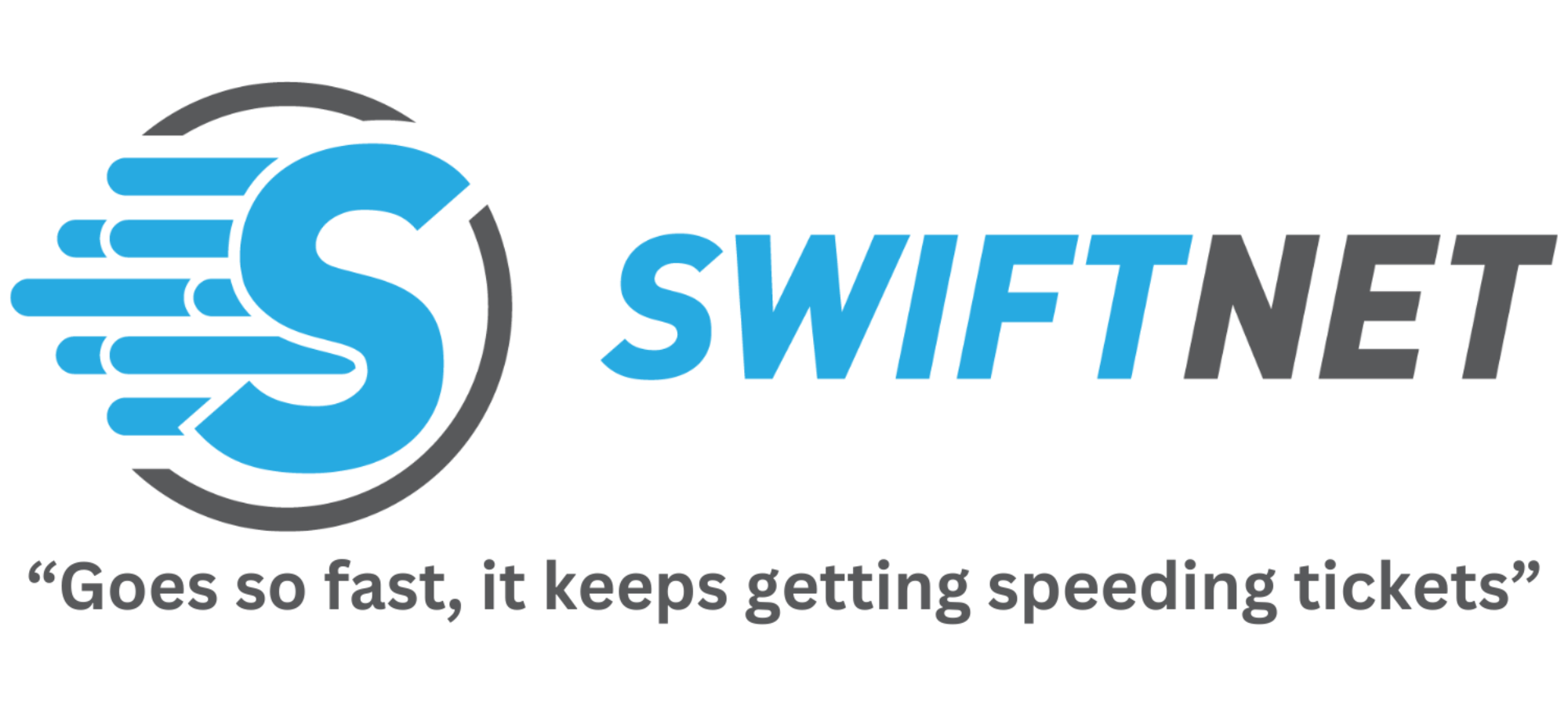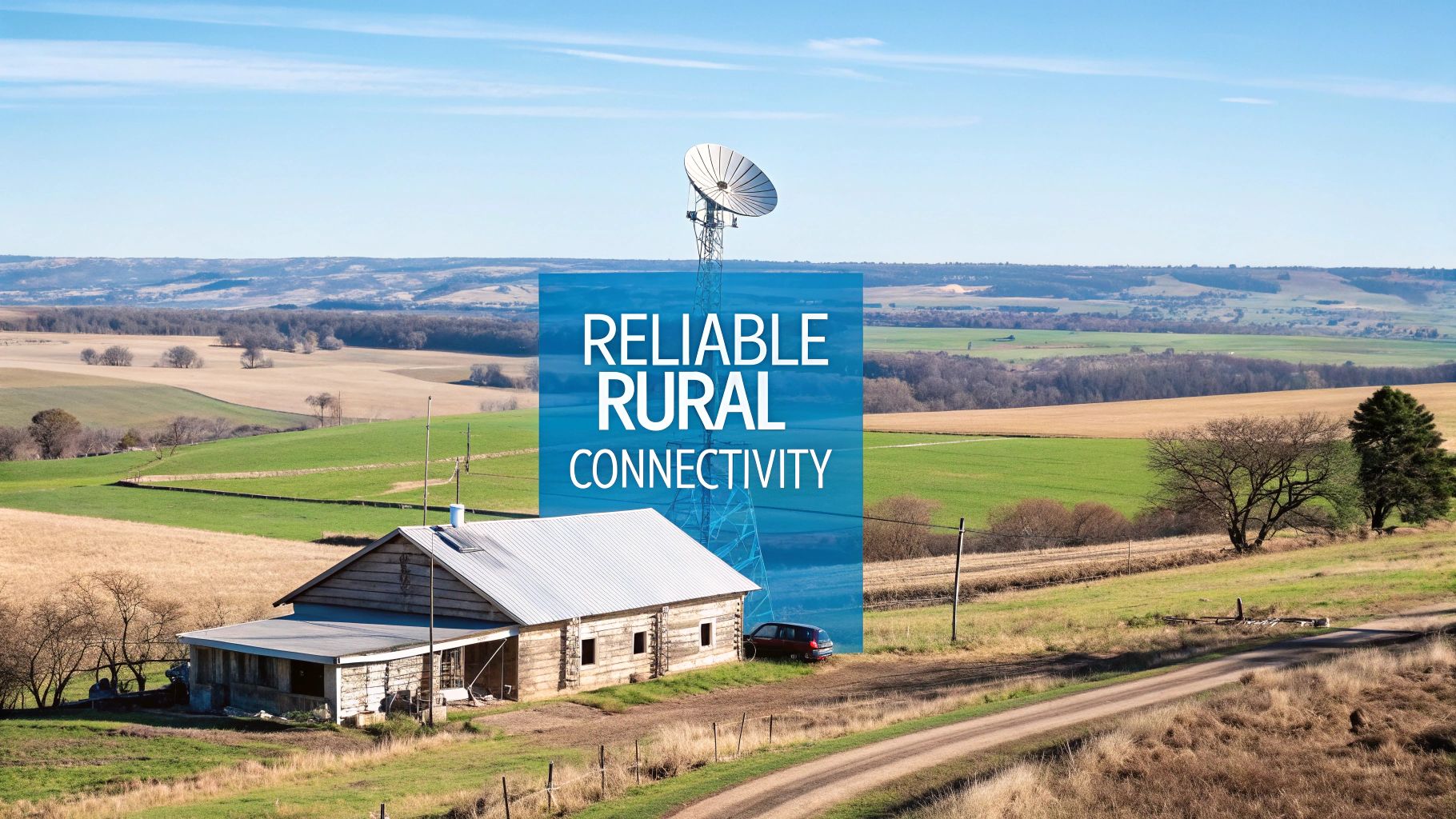

· By James
Top 8 Best Rural Internet Options for Reliable Connectivity
Connecting the Countryside: Your Guide to Rural Internet
Finding reliable internet in rural areas can be challenging. This guide presents the 8 best rural internet options for 2025, helping you stay connected no matter where you are. Whether you're an RV traveler, remote worker, or simply live outside the reach of fiber optic internet, we'll break down the pros, cons, and key features of each option. Discover the best rural internet options, from satellite internet like Starlink, Viasat, and HughesNet, to fixed wireless, T-Mobile Home Internet, and emerging 5G solutions. Choose the right connection for your needs and get back online.
1. SwiftNet Wifi
SwiftNet Wifi offers a high-speed 5G internet solution specifically designed to cater to the needs of rural residents and RV travelers. This makes it a compelling option for those struggling with limited connectivity options outside of urban areas. For digital nomads, remote workers, and those simply wanting to stay connected on the road, SwiftNet Wifi aims to provide a reliable and fast connection regardless of location. This focus on mobility and rural coverage is what earns it a spot on our list of best rural internet options. Learn more about SwiftNet Wifi
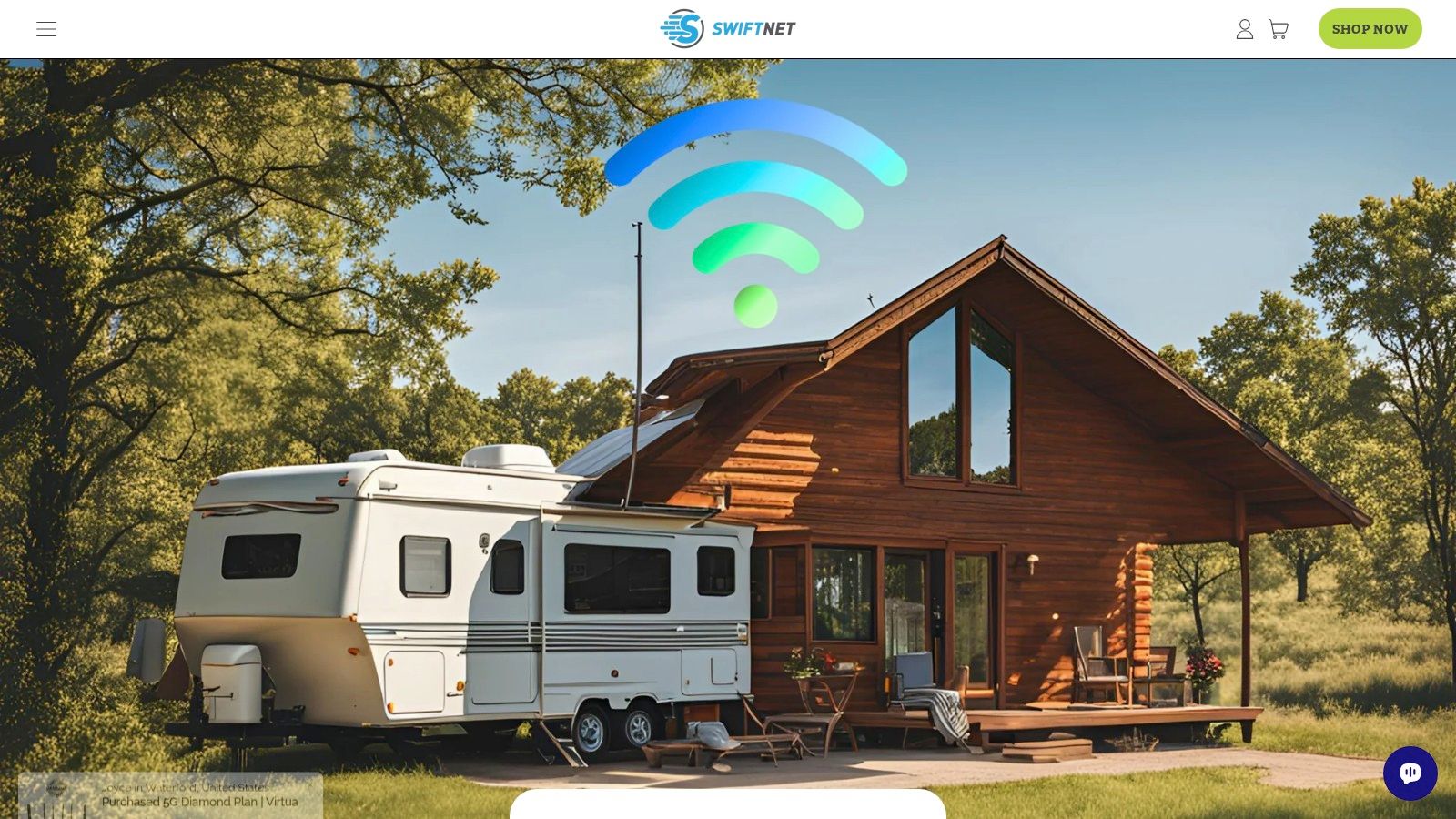
While many rural internet providers rely on older technologies like DSL or satellite, SwiftNet Wifi leverages the power of 5G. This allows for significantly faster speeds and lower latency compared to these alternatives, making activities like streaming, video conferencing, and online gaming much more enjoyable. Specifically for RV travelers, this means staying connected while on the move, accessing work resources, and enjoying entertainment without interruption. For rural residents, it offers a viable alternative to slow and unreliable connections, opening up opportunities for remote work, online education, and staying connected with loved ones.
Unfortunately, specific pricing and technical requirements are not readily available on the SwiftNet Wifi website. It's highly recommended to contact them directly to obtain detailed information about data plans, equipment costs, installation procedures, and data limits. This will allow you to understand the total cost of ownership and ensure the service meets your specific needs. For example, if you're a heavy data user, you'll need to inquire about data caps and overage charges. Similarly, understanding the technical requirements will help determine if your location has adequate 5G coverage.
Compared to satellite internet, SwiftNet Wifi's 5G service generally offers lower latency, which is crucial for real-time applications. However, 5G availability can be patchy in some extremely remote areas, whereas satellite internet often provides broader, albeit slower, coverage. Compared to DSL, SwiftNet Wifi's speed advantage is substantial. However, if DSL is available in your rural location, it might offer a more cost-effective option if your internet usage is light.
Implementation for RV travelers is likely straightforward, possibly involving a portable 5G modem or router that can be easily set up within the vehicle. For rural residents, installation may require professional assistance to ensure optimal signal reception and equipment configuration. It's recommended to clarify the installation process with SwiftNet Wifi directly.
Visit the SwiftNet Wifi website to explore their offerings and contact them for personalized information about plans and availability in your area.
2. Starlink
For those seeking reliable internet access in rural locations, Starlink has emerged as a game-changer among the best rural internet options. Leveraging SpaceX's innovative low Earth orbit (LEO) satellite network, Starlink delivers high-speed broadband internet to areas often underserved by traditional providers. This makes it a particularly attractive option for RV travelers, RV owners, people living in rural areas without fiber optic internet, remote workers, and digital nomads. Forget grappling with slow DSL connections or expensive, limited data satellite internet plans; Starlink offers a viable solution for staying connected in the digital age, no matter how remote your location.
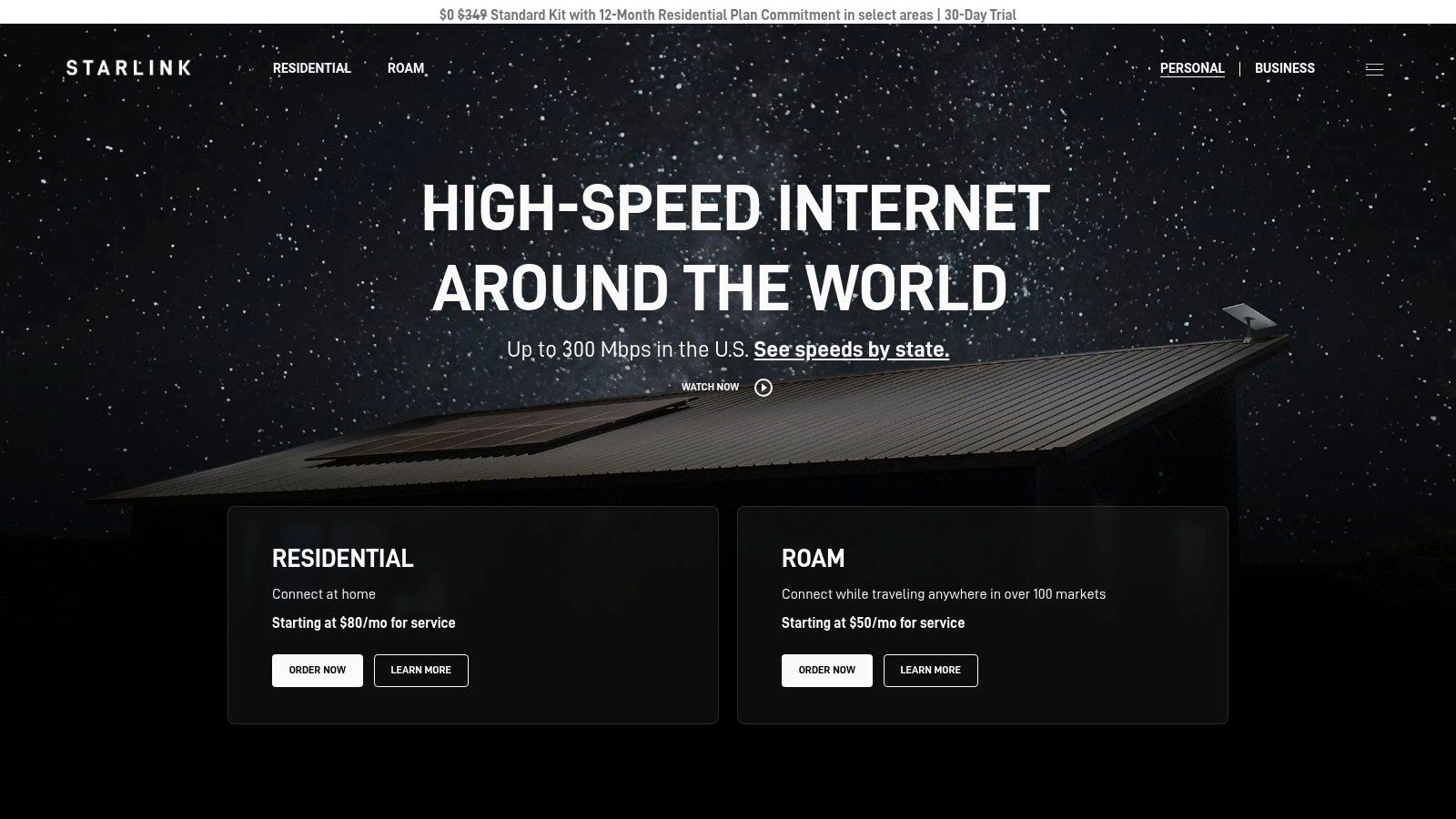
Starlink’s impressive performance stems from its constellation of LEO satellites. Unlike traditional geostationary satellites, which orbit much farther from Earth, Starlink's closer proximity significantly reduces latency. This translates to faster data transfer speeds and a smoother online experience, making activities like video conferencing, online gaming, and streaming much more feasible in rural settings. With download speeds typically ranging from 100-300 Mbps in most rural areas and a latency of 20-40ms, Starlink provides performance comparable to, and in some cases exceeding, terrestrial broadband options. Most plans also boast no data caps, liberating users from the constraints of limited data usage.
The Starlink system is designed for self-installation. The kit includes a satellite dish, officially called a terminal, which automatically tracks the Starlink satellites. This self-tracking feature simplifies setup and ensures a consistent connection. While the terminal requires a clear view of the northern sky, the automated tracking eliminates the need for manual adjustments. For RV owners and travelers, this portability and ease of setup are invaluable benefits.
While Starlink is a powerful solution for best rural internet options, it’s important to consider both the pros and cons. On the plus side, the wide availability in rural areas makes it a lifeline for those without other broadband options. The significantly faster speeds and lower latency compared to traditional satellite internet are game-changing. The absence of long-term contracts provides flexibility, and the straightforward self-installation process gets users connected quickly.
However, there are some drawbacks. The upfront equipment cost of $599+ can be a significant investment. The monthly service cost of $110-$120/month for standard service is higher than some other options, though the performance justifies the cost for many users. Service can be affected by adverse weather conditions and obstructions that block the terminal’s view of the sky.
Technical Requirements & Setup Tips:
- Clear View of the Northern Sky: Ensure your chosen installation location has an unobstructed view of the northern sky. Use the Starlink app to identify the optimal placement for your dish.
- Power Source: The Starlink terminal requires a standard power outlet.
- Wi-Fi Router: The Starlink kit includes a Wi-Fi router.
Starlink offers a compelling solution for those seeking reliable, high-speed internet in rural areas. While the upfront and monthly costs are higher than some alternatives, the performance and availability make it a worthwhile investment for many users. For more information and to check availability in your area, visit the Starlink website: https://www.starlink.com/
3. Viasat
Viasat is a prominent satellite internet provider offering service to those seeking one of the best rural internet options across the United States. Leveraging geostationary satellites positioned approximately 22,000 miles above Earth, Viasat can deliver internet access to virtually any location with an unobstructed view of the southern sky. This makes it a valuable option for RV travelers, RV owners, and people living in rural areas without access to fiber optic internet or reliable land-based options. The company offers a variety of plan options with different speeds and data allowances, catering to a range of needs and budgets. This flexibility is crucial for those who work online remotely, whether from a fixed rural location or while traveling.

Viasat stands out amongst other best rural internet options due to its widespread availability. While download speeds can reach up to 150 Mbps in select areas, it's important to note that speeds are generally lower than land-based alternatives. However, for those in remote locations, this speed is often a significant upgrade over dial-up or other limited options. Data plans range from 40GB to unlimited options (with priority data). The "unlimited" plans don't have hard data caps; instead, speeds are reduced after the allocated priority data is used. This can be a good option for those who need consistent access but don't necessarily require high speeds for all their online activities. Professional installation is included, ensuring that the equipment is set up correctly for optimal performance. The included Wi-Fi modem/router simplifies the setup process and eliminates the need for additional hardware purchases. You can learn more about Viasat and their specific offerings for your area.
Pros:
- Wide Availability: Perhaps the biggest advantage, Viasat is available in virtually all rural areas of the continental US, making it ideal for those in remote locations.
- Higher Data Allowances: Compared to other satellite internet providers, Viasat offers more generous data allowances.
- No Hard Data Caps: While speeds may be reduced, you won't lose access after exceeding your priority data.
- No Equipment Purchase Required: The necessary equipment is included, simplifying the setup and reducing upfront costs.
Cons:
- High Latency: A significant drawback of satellite internet is high latency (600-800ms), which can impact real-time applications like video conferencing and online gaming.
- Cost: Viasat is generally more expensive than land-based internet options, with prices ranging from $70 to $300 per month depending on the chosen plan.
- Contract Requirement: Typically, a 2-year contract is required for service.
- Speed Reductions: While there are no hard data caps, speeds will be reduced after the priority data allowance is used.
Viasat's website (https://www.viasat.com/) offers detailed information on plan options, pricing, and availability in your area. While the cost and latency may be a concern for some, its broad availability makes Viasat a viable, and often the only, high-speed internet solution for many in rural areas seeking the best rural internet options.
4. T-Mobile Home Internet
T-Mobile Home Internet is carving a niche for itself among the best rural internet options, particularly for those seeking an alternative to traditional wired connections like DSL or cable. Leveraging T-Mobile's growing 4G LTE and 5G cellular network, this fixed wireless service offers a viable solution for RV travelers, RV owners, remote workers, and those living in rural areas without fiber optic internet access.
This service distinguishes itself by offering internet access where other options may be limited or non-existent. Instead of relying on physical cables, T-Mobile Home Internet uses a wireless gateway device that connects to nearby T-Mobile cellular towers. This makes it a particularly attractive option for those in remote locations or for those who want the flexibility of easily moving their internet service. Think about it: you can take your internet with you in your RV as you travel, ensuring you stay connected wherever T-Mobile's network reaches. For those living in rural areas, it can be a lifeline for work, entertainment, and staying connected with the world.
How it Works & What You Get:
T-Mobile Home Internet provides a simple, plug-and-play setup. The included wireless gateway receives the cellular signal and broadcasts a Wi-Fi network within your home or RV. Typical speeds range from 35-115 Mbps, but this varies depending on location and network congestion. It's important to understand that, like all cellular-based services, performance is directly tied to signal strength.
One of the most significant advantages of T-Mobile Home Internet is its straightforward, flat-rate pricing, usually between $50-$60/month with autopay. This price includes unlimited data with no caps or throttling, meaning you can stream, download, and work online without worrying about overage charges. Furthermore, there are no equipment fees or long-term contracts required, adding to the service's overall affordability and flexibility.
Pros:
- Affordable flat-rate pricing: At $50-$60/month with autopay, it's a budget-friendly option.
- No data caps or overage charges: Enjoy unlimited data usage.
- Simple setup: Self-installation with the included wireless gateway eliminates the need for a technician visit.
- No equipment fees or long-term contracts: Offers flexibility and avoids hidden costs.
Cons:
- Limited availability: Coverage isn't available in all rural areas, and even within coverage areas, not all addresses are eligible. Check T-Mobile's website for availability.
- Speed and reliability depend on cellular signal strength: Performance can vary based on location and network congestion. You may experience slower speeds in areas with weaker signals or during peak usage times.
- Potential for slowdowns during peak usage: Like any shared internet service, speeds can be affected by high network traffic.
Implementation Tips:
- Check availability: Before committing, verify that T-Mobile Home Internet is available at your specific location via their website (https://www.t-mobile.com/home-internet).
- Consider a signal booster: If you live in an area with marginal signal strength, a cellular signal booster can potentially improve performance.
- Monitor your usage: While there are no data caps, it's still good practice to monitor your usage to understand your typical data consumption.
T-Mobile Home Internet earns its place on the list of best rural internet options because of its affordability, ease of setup, and unlimited data. While it may not be suitable for everyone due to its dependence on cellular signal strength, it offers a compelling solution for those seeking an affordable and flexible alternative to traditional wired internet, especially in rural areas where other options are limited. It's particularly attractive for those embracing a mobile lifestyle, such as RV travelers and remote workers, who prioritize connectivity and convenience.
5. HughesNet
HughesNet is a prominent player in the satellite internet arena and a viable option for those seeking internet access in rural areas where other technologies like fiber optics or cable are unavailable. As one of the most established satellite internet providers, HughesNet boasts coverage across virtually the entire continental United States, making it a practical choice for RV travelers, remote workers, and rural residents struggling with limited connectivity options. This widespread availability contributes significantly to its place among the best rural internet options. HughesNet focuses on delivering consistent speeds across its plans, prioritizing reliable connectivity rather than tiered speed offerings. The primary differentiator between plans lies in the amount of high-speed data provided each month.
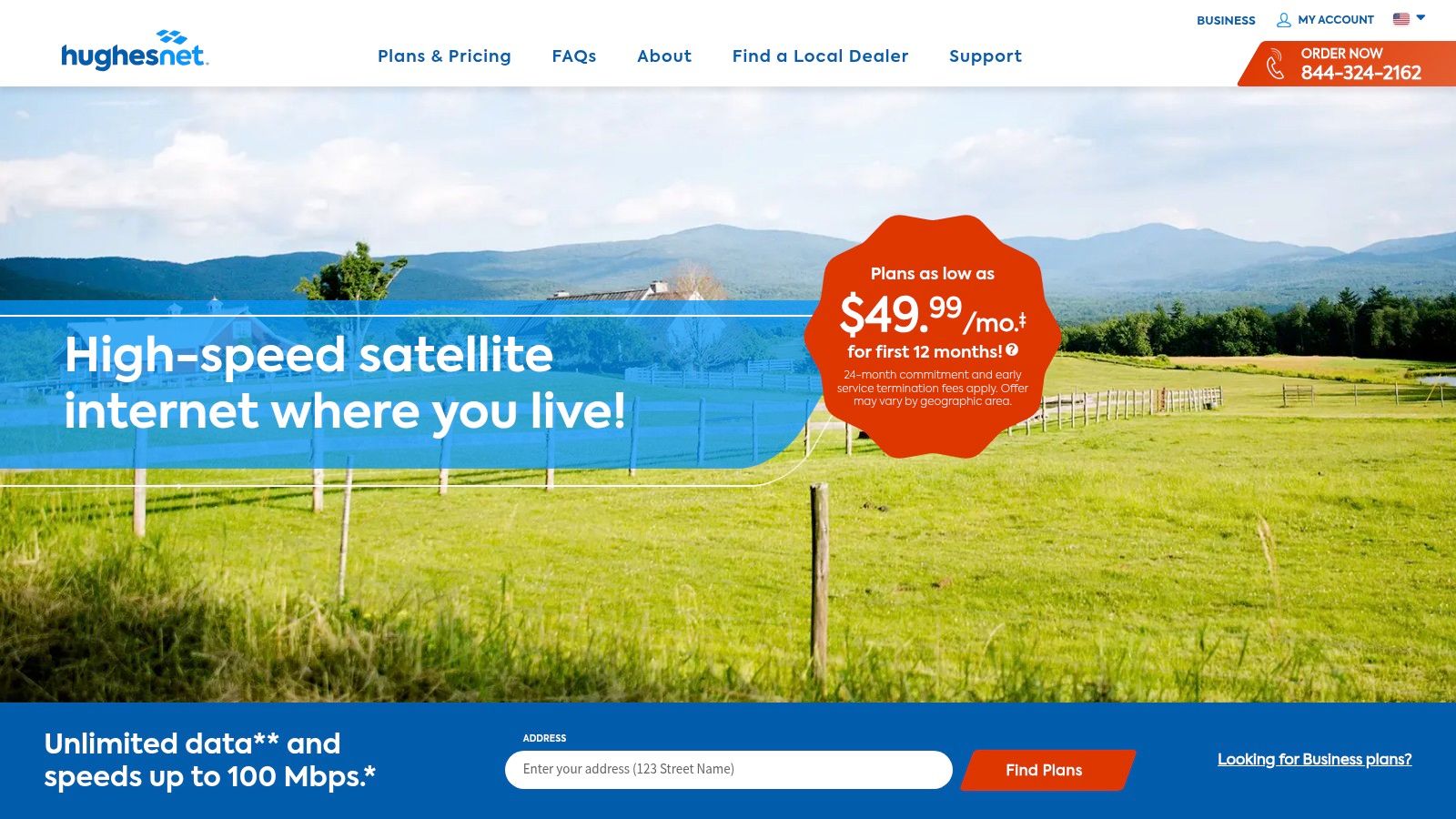
HughesNet offers download speeds of 25 Mbps on all plans, which is suitable for everyday tasks like browsing, email, and streaming standard-definition video. Data plans range from 15GB to 75GB per month, catering to varying usage needs. A significant advantage for those working odd hours or needing to download large files overnight is the "Bonus Zone," which provides an additional 50GB of data between 2 am and 8 am. This feature can be a lifesaver for remote workers in rural areas who need to conduct large file transfers or backups during off-peak hours. Professional installation is included, ensuring the equipment is set up correctly and optimized for performance. The provided modem/router also has built-in Wi-Fi, simplifying the setup process for users.
For RV travelers, HughesNet's nationwide availability makes it a practical solution for staying connected on the road. However, the latency inherent in satellite internet (600-800ms) can make activities like online gaming and video calls challenging. For remote workers, the consistent 25 Mbps speed allows for reliable access to online work platforms, but the limited data allowances and potential speed reductions after exceeding the limit need to be carefully considered. Choosing a plan with sufficient data for your work needs is crucial.
Pricing: Plans typically range from $65 to $160 per month depending on the data allowance.
Technical Requirements: HughesNet requires a clear view of the southern sky for optimal satellite communication. Professional installation ensures correct dish placement and alignment.
Pros:
- Available virtually everywhere in the continental US
- Consistent 25 Mbps speeds regardless of the chosen plan
- No hard data caps (speeds are reduced after the allowance is used, but connectivity continues)
- Bonus Zone data for off-peak usage
Cons:
- High latency (600-800ms), impacting real-time applications like gaming and video calls
- Relatively expensive for the amount of data provided
- Speeds reduced to 1-3 Mbps after the data allowance is depleted
- Typically requires a 2-year contract
Website: https://www.hughesnet.com/
While HughesNet isn't perfect, its widespread availability and consistent speed make it a valuable internet option for those in rural areas and on the move who lack access to other high-speed internet options. Carefully consider your data needs and budget to determine if HughesNet is the right choice for your specific situation. For those prioritizing consistent connectivity over low latency and high data caps, HughesNet presents a reliable solution to the challenges of rural internet access.
6. 4G LTE Home Internet (Various Providers)
For those seeking the best rural internet options, 4G LTE home internet presents a compelling solution, especially for RV travelers, RV owners, remote workers, and those living in rural areas lacking fiber optic connectivity. Leveraging existing cellular networks, providers like UbiFi, Nomad Internet, and Calyx Institute offer a viable alternative to traditional wired connections and even satellite internet. These services essentially repurpose cellular data for home internet use, delivering connectivity through a dedicated router that creates a Wi-Fi network. This makes it a practical choice for those seeking reliable internet access beyond the reach of urban infrastructure. Learn more about 4G LTE Home Internet (Various Providers)
How it Works:
4G LTE home internet works by connecting a specialized router to the nearest cell towers of major carriers like AT&T, Verizon, or T-Mobile. This router then broadcasts a Wi-Fi signal, allowing multiple devices to connect. Speeds and reliability are heavily dependent on the strength of the local cellular signal, so performance can vary. For users in fringe areas with weaker signals, external antennas are available to boost reception and improve performance. This flexibility makes it particularly appealing to RV owners and travelers who frequently change locations.
Features and Benefits:
- Speeds: Typically range from 10-50 Mbps. While this isn't as fast as fiber, it’s generally sufficient for streaming, video conferencing, and online work, especially in areas with limited alternatives.
- Unlimited Data: Many 4G LTE home internet providers offer truly unlimited data plans without throttling, a huge advantage for heavy internet users. This is a significant differentiator compared to satellite internet, which often imposes data caps.
- No Contracts: The flexibility continues with month-to-month service options, eliminating the long-term commitments often required by traditional ISPs. This is ideal for RV travelers or those who value flexible living arrangements.
- Portability: The equipment is generally portable, making it easy to move the service to different locations. This is a game-changer for digital nomads, RV enthusiasts, and those living in temporary housing.
- Lower Latency than Satellite: While speeds may not match fiber, 4G LTE typically boasts lower latency than satellite internet, resulting in a more responsive online experience, particularly crucial for activities like online gaming.
Pros:
- Truly unlimited data without throttling is a major draw.
- Flexibility with no contracts provides greater control over service.
- Functionality in areas with cellular coverage but no wired options makes it a viable rural solution.
- Lower latency compared to satellite internet improves the online experience.
Cons:
- Reliability is contingent on the strength and availability of the local cellular signal.
- Service disruptions can occur due to carrier policy changes, something to be aware of.
- Higher monthly costs ($80-$150/month) compared to urban internet options.
- Additional equipment like external antennas may be necessary in fringe areas, adding to the initial setup cost.
Example Provider & Website:
Calyx Institute is just one example of a 4G LTE home internet provider. Others include UbiFi and Nomad Internet. You can explore Calyx Institute's offerings at https://calyxinstitute.org/. It's important to research various providers to compare plans, pricing, and network availability in your specific area to find the best rural internet options for your needs. Consider factors such as typical data usage, required speeds, and budget when making a decision.
7. Fixed Wireless Internet: A Rural Connectivity Contender
For those seeking reliable internet access beyond the reach of fiber optic cables, fixed wireless internet (FWI) emerges as a strong contender among the best rural internet options. This technology offers a compelling alternative to satellite internet, particularly for RV travelers, RV owners, remote workers, and anyone living in rural areas without access to fiber.
Fixed wireless operates by establishing a connection between an antenna installed at your home and a nearby tower, usually within a 5-10 mile radius. Unlike cellular internet which relies on existing mobile networks, fixed wireless providers often build and maintain their own network infrastructure specifically optimized for internet service. This localized approach, often championed by Wireless Internet Service Providers (WISPs), contributes to better service and personalized customer support.
How Does It Work?
A professional installation is required to mount an antenna on your property, typically on the roof or a high point with a clear line of sight to the provider's tower. This antenna transmits and receives data signals, providing internet access to your home or RV. Because it relies on line-of-sight, obstructions like dense trees or hills can impact service quality. The installation fees for the equipment and setup usually range from $100-$300.
Features and Benefits:
- Speeds: Expect speeds between 10-100 Mbps, though the actual speed you experience will depend on your provider, your distance from the tower, and network congestion. While not as fast as fiber, this is generally sufficient for streaming, video conferencing, and online gaming.
- Latency: A significant advantage of fixed wireless over satellite is lower latency, usually between 10-40ms. This makes it more responsive for real-time applications like video calls and online gaming.
- Data Allowance: Many fixed wireless providers offer unlimited data plans or generous data allowances, which is particularly important for remote workers and those who rely heavily on internet access.
- Reliability: Fixed wireless is generally more reliable than satellite internet, especially during inclement weather. Rain or snow rarely impact service, unlike satellite which can experience outages during heavy precipitation.
- Local Support: Many fixed wireless providers are local or regional companies, which often translates to more personalized customer service and quicker response times.
- Static IP Address: Fixed wireless often includes the option for a static IP address, which can be essential for certain online activities like running a server or using specific software.
Pros & Cons at a Glance:
Pros:
- Lower latency than satellite
- Often locally owned companies with personalized customer service
- More reliable in adverse weather than satellite
- Usually offers higher data allowances or unlimited data
Cons:
- Limited availability based on terrain and distance from towers
- Installation fees can be significant ($100-$300)
- Line-of-sight to tower typically required
- Service quality can vary significantly between providers
Is Fixed Wireless Right for You?
If you live in a rural area with limited internet options and can establish a clear line of sight to a provider's tower, fixed wireless is worth considering. It's a particularly attractive option for those who need reliable internet for work, entertainment, or staying connected. Compare local providers, paying attention to speeds, data allowances, and customer reviews to find the best fit for your needs. You can find local providers through the Wireless Internet Service Providers Association (WISPA) directory: https://wispa.org/find-a-wisp/
By weighing these factors and comparing fixed wireless to other best rural internet options, you can make an informed decision about the best connectivity solution for your specific circumstances.
8. AT&T Fixed Wireless
For those seeking reliable internet access in rural locations, AT&T Fixed Wireless presents a viable option among the best rural internet options. This service leverages AT&T's existing cellular network, delivering internet through a dedicated outdoor antenna installed at your property, which communicates with a nearby cell tower. This makes it a particularly attractive option for those in rural areas underserved by traditional wired broadband like cable or fiber. This fixed wireless solution distinguishes itself from mobile hotspots by offering a more stable connection thanks to the dedicated equipment and directional antenna. This is a significant advantage for RV travelers, RV owners, and those who live and work remotely in rural areas without fiber optic internet access.
AT&T Fixed Wireless provides download speeds up to 25 Mbps and upload speeds up to 10 Mbps. While these speeds may not match the blistering pace of urban fiber connections, they are generally sufficient for everyday tasks such as web browsing, video streaming, and online work. It’s important to remember that this is a considerably better performance than satellite internet, especially in terms of latency, which can be crucial for video conferencing or online gaming. The service comes with a 350GB monthly data allowance, which is ample for many users, but heavy data users should be mindful of the overage charges of $10 per 50GB.
Key Features and Benefits:
- Stable Connection: Unlike mobile hotspots that rely on a shared cellular connection, AT&T Fixed Wireless uses a dedicated connection, resulting in greater stability and fewer interruptions.
- Reasonable Price: The service typically costs $70/month or less when bundled with other AT&T services, making it a competitively priced option for rural internet.
- Lower Latency than Satellite: While not as fast as fiber, AT&T Fixed Wireless offers significantly lower latency than satellite internet, which is important for real-time applications.
- Professional Installation: AT&T handles the installation of the outdoor antenna and Wi-Fi gateway, ensuring proper setup and optimal performance. This is especially helpful for those less technically inclined.
- Backed by AT&T: The service is provided by a major telecommunications company with established customer service channels, offering a degree of reliability and support.
Pros:
- More stable than mobile hotspots
- Reasonable monthly price for rural service
- Lower latency than satellite internet
- Professional installation included
- Backed by a major telecommunications company
Cons:
- 350GB monthly data cap
- Overage charges can accumulate
- Limited availability, even within AT&T's service areas
- Speeds lower than many urban broadband options
Implementation Tips:
- Check Availability: Before getting too excited, verify service availability at your specific location on the AT&T website. Rural availability can be patchy.
- Consider Data Usage: Evaluate your typical monthly internet usage to determine if the 350GB data allowance is sufficient.
- Bundle for Savings: Explore bundling options with other AT&T services (like phone or DirecTV) to potentially lower your monthly internet bill.
For RV travelers and remote workers, the stability offered by AT&T Fixed Wireless is a major advantage over mobile hotspots, making it a contender for one of the best rural internet options available. While the data cap and speed limitations should be considered, the relatively affordable price and professional installation make it a worthwhile option for those seeking reliable internet access in areas with limited broadband choices. Learn more and check availability at https://www.att.com/internet/fixed-wireless/.
Top 8 Rural Internet Providers Comparison
| Provider | Core Features / Speeds | User Experience / Quality ★ | Value Proposition 💰 | Target Audience 👥 | Unique Selling Points ✨ |
|---|---|---|---|---|---|
| 🏆 SwiftNet Wifi | High-speed 5G for rural & RV travelers | ★★★★☆ Reliable & fast in underserved areas | 💰 Competitive pricing, flexible | 👥 Rural homes, RV users | ✨ 5G optimized for mobile use |
| Starlink | 100-300 Mbps, low latency (20-40ms) | ★★★★☆ Low latency, no data caps | 💰 High upfront & monthly costs | 👥 Rural & remote, tech-savvy | ✨ LEO satellites, wide rural coverage |
| Viasat | Up to 150 Mbps, various data plans | ★★★☆☆ High latency (600-800ms) | 💰 Expensive, requires contract | 👥 Rural US homes | ✨ No equipment purchase needed |
| T-Mobile Home Internet | 35-115 Mbps, unlimited data | ★★★☆☆ Speed varies with signal | 💰 Affordable flat-rate | 👥 Rural homes with 4G/5G coverage | ✨ Simple setup, no contracts |
| HughesNet | 25 Mbps, 15-75GB data plans | ★★☆☆☆ High latency (600-800ms) | 💰 Mid-to-high pricing, contracts | 👥 Rural US users | ✨ Bonus Zone off-peak data |
| 4G LTE Home Internet | 10-50 Mbps, often unlimited data | ★★★☆☆ Depends on cellular coverage | 💰 Moderate to high monthly costs | 👥 Rural with cellular signal | ✨ Portable & flexible plans |
| Fixed Wireless Internet | 10-100 Mbps, professional installation | ★★★☆☆ Lower latency (10-40ms) | 💰 Installation fees possible | 👥 Rural areas near towers | ✨ Local providers, stable weather performance |
| AT&T Fixed Wireless | Up to 25 Mbps, 350GB monthly data | ★★★☆☆ Stable but data limited | 💰 Affordable; data overage fees | 👥 Select rural areas | ✨ Major brand, professional install |
Staying Connected: Making the Right Choice for Your Rural Needs
Finding the best rural internet options can feel like navigating a complex maze, but with the right tools and information, you can break free from connectivity constraints. We've explored a range of solutions, from satellite internet providers like Starlink, Viasat, and HughesNet to fixed wireless options like AT&T Fixed Wireless and other emerging technologies. We've also examined cellular-based options like T-Mobile Home Internet and 4G LTE home internet from various providers. Each solution presents its own set of advantages and disadvantages concerning speed, data limits, cost, and availability. The most important takeaways are to carefully consider your individual needs and budget and to diligently compare plans before committing. Whether you’re an RV traveler working remotely, a rural homeowner streaming movies, or simply need a reliable connection for everyday tasks, the perfect solution for your unique situation is out there among the best rural internet options.
For those prioritizing flexibility and seeking a streamlined solution that integrates multiple internet sources, SwiftNet Wifi is worth exploring. It offers a compelling alternative, potentially simplifying the management of multiple connections and optimizing your online experience. Learn more about how SwiftNet Wifi can help you stay seamlessly connected on the road and in remote locations by visiting SwiftNet Wifi.

